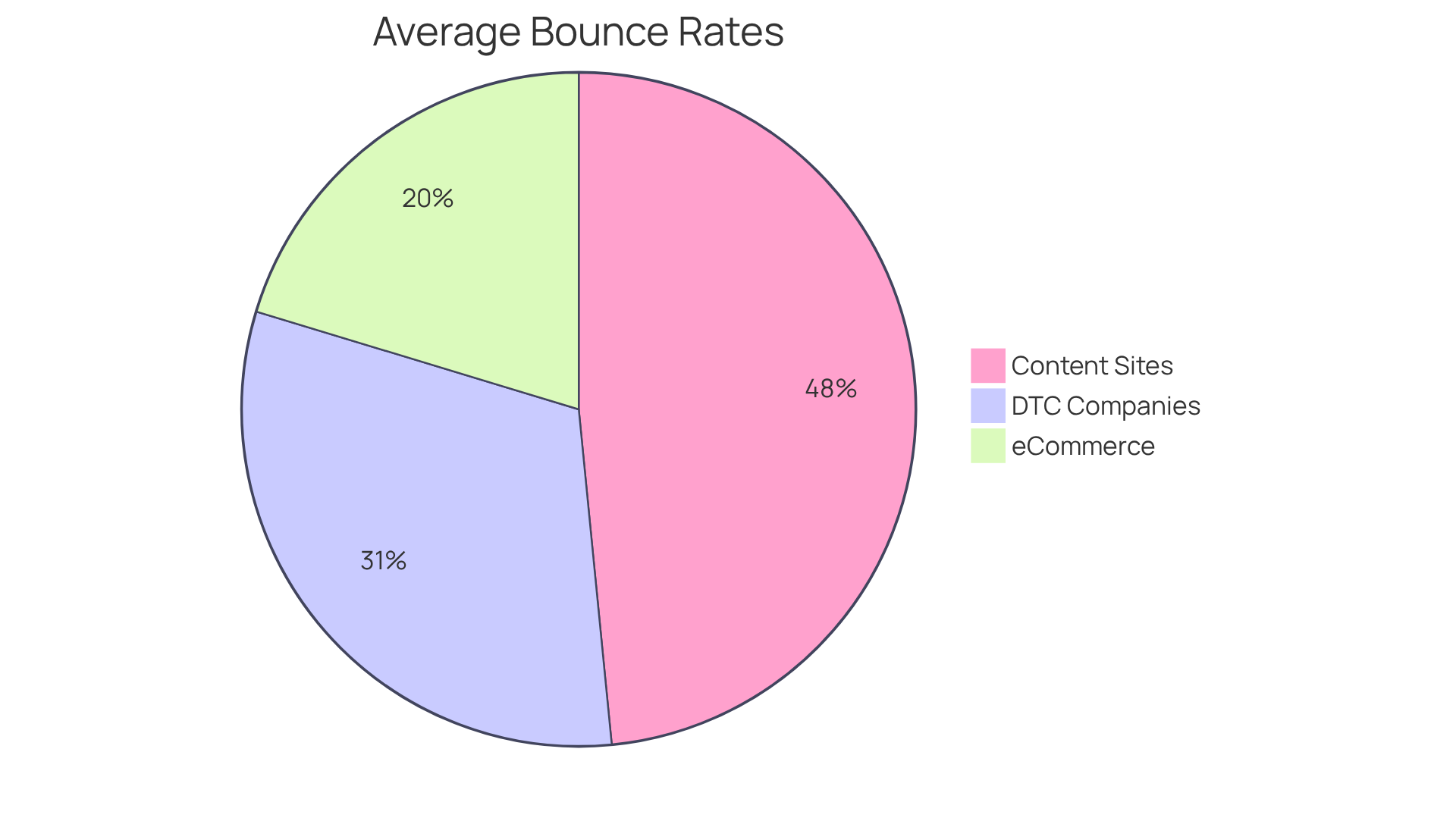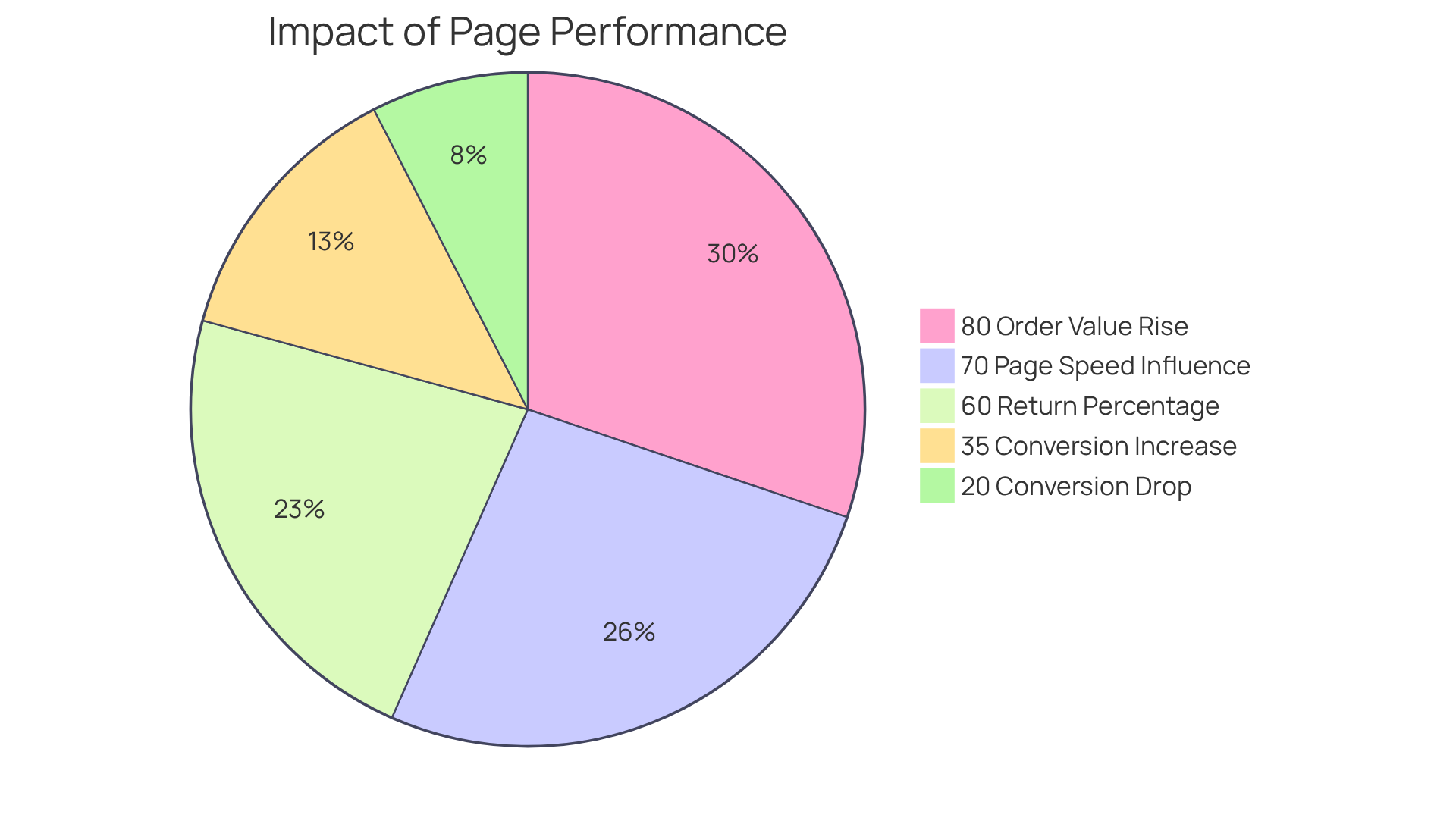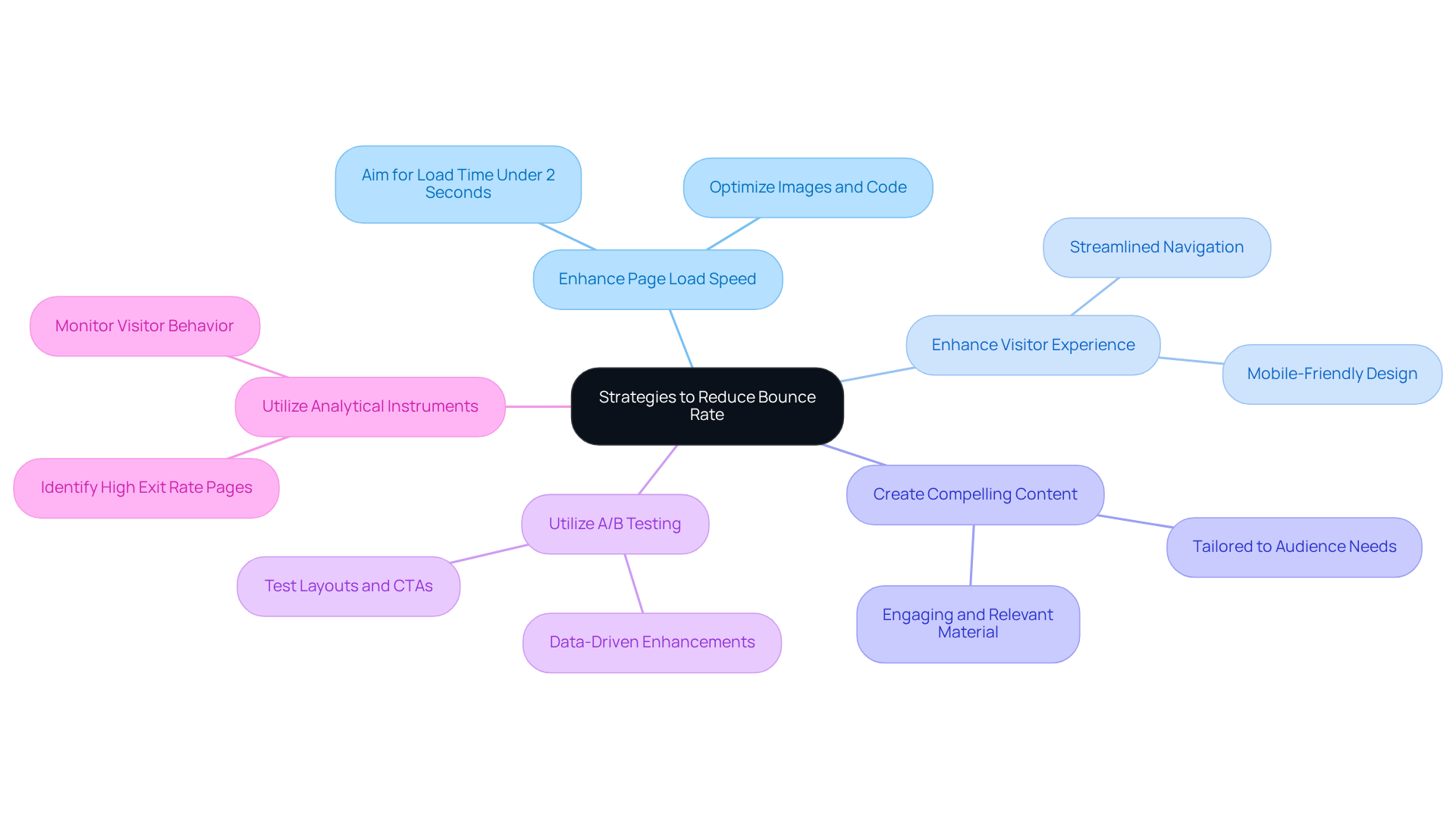
Overview
The average bounce rate exhibits significant variation across industries, with Direct-to-Consumer (DTC) brands typically facing rates ranging from 45% to 55%. This statistic underscores the critical role of user engagement in the success of these brands. It is essential for DTC brands to grasp and enhance this metric, as it directly influences customer experience and conversion rates. Elevated bounce rates often signify missed sales opportunities stemming from visitor disengagement. Thus, addressing this issue is paramount for driving growth and maximizing revenue potential.
Introduction
Understanding the dynamics of website engagement is paramount for direct-to-consumer (DTC) brands. The average bounce rate stands as a critical indicator of visitor interaction and marketing effectiveness. Given the varying benchmarks across industries, recognizing these differences empowers brands to refine their strategies and enhance customer experiences.
Yet, many DTC companies face the challenge of high exit percentages. This raises an essential question: how can these brands transform statistical insights into actionable strategies that foster deeper connections and ultimately drive sales?
Define Average Bounce Rate and Its Importance for DTC Brands
The typical exit percentage evaluates the proportion of visitors who access a webpage and leave without engaging with additional pages on the site. For direct-to-consumer (DTC) brands, this metric is crucial as it serves as a barometer for consumer engagement and the effectiveness of marketing strategies. A high level of disengagement often signifies that visitors are not finding what they expect, which can result in missed sales opportunities. For instance, blogs and content websites typically experience exit percentages ranging from 70% to 90%, reflecting visitor behavior where individuals often seek specific information and depart upon finding it.
Understanding abandonment statistics enables DTC brands to pinpoint areas that require enhancement in website design, content quality, and the overall visitor experience. This insight is vital for improving conversion rates and fostering customer loyalty. As industry experts have noted, exceptional customer experiences are essential for sustainable competitive differentiation. Brands that prioritize user interaction can significantly reduce exit levels, leading to increased customer loyalty and greater lifetime value.
Case studies illustrate the impact of visitor drop-offs on direct-to-consumer companies. For example, ecommerce sites generally observe an average bounce rate by industry that ranges from 20% to 45%, with product pages typically outperforming checkout pages. By monitoring these metrics, companies can identify friction points in the shopping process and implement strategies to enhance user experience. As Tony Hsieh, former CEO of Zappos, emphasized, a brand's true value lies in the experience it provides, not merely in the products it sells. Therefore, focusing on reducing abandonment statistics is not solely about improving metrics; it’s about cultivating meaningful relationships with clients that foster long-term success.

Explore Average Bounce Rate Trends Across Industries
The variation in bounce frequencies is evident when considering the average bounce rate by industry. eCommerce platforms typically report average exit percentages ranging from 20% to 45%. In contrast, content-rich sites may see figures soaring as high as 65% to 90%. For direct-to-consumer (DTC) companies, the average exit percentage generally falls between 45% and 55%.
Recognizing these trends is vital for DTC companies, as it enables them to establish realistic performance benchmarks and adopt effective strategies informed by the average bounce rate by industry, especially from sectors with lower exit frequencies.
For instance, clothing companies often benefit from diminished exit rates due to their use of captivating visuals and intuitive navigation, providing a valuable framework for other DTC businesses aiming to enhance user engagement and loyalty.
Parah Group's case studies illustrate how strategic optimizations can produce remarkable results; for example, an apparel company witnessed a 35% increase in conversion rates and a 10% rise in revenue per visitor after implementing social proof and reducing pop-ups. Similarly, a cannabis business improved its exit percentage by 25% through tailored landing pages and upsell strategies.
Furthermore, as DTC sales are projected to grow significantly, improving drop-off statistics becomes increasingly essential for maintaining market competitiveness. Focusing on mobile optimization is critical, given that mobile users frequently exhibit heightened drop-off tendencies, making it imperative for DTC companies to create seamless mobile experiences.

Analyze the Impact of Bounce Rate on DTC Brand Performance
A high exit frequency significantly impairs a DTC brand's performance, signaling that potential customers are leaving without engaging with the content or products. For instance, a return percentage of 60% indicates that 60% of visitors do not delve deeper into the site, potentially resulting in substantial lost sales.
Research shows that for every second delay in page load time, conversion rates can plummet by as much as 20%, underscoring the critical link between site performance and user engagement. Furthermore, 70% of shoppers report that page speed influences their willingness to purchase from an online seller, accentuating the importance of improving exit percentages.
Brands that effectively reduce their average bounce rate by industry often experience heightened customer interaction, increased average order values, and enhanced returns on marketing investments. For example:
- Parah Group aided a $30M clothing label in redesigning its homepage to highlight social proof and reviews, reduce unnecessary pop-ups, and optimize product pricing, resulting in a 35% increase in conversion rates and a 93% improvement in homepage scroll depth.
- A $15M cleaning product brand achieved an 80% rise in average order value after implementing strategic modifications to their purchasing process, such as testing free shipping thresholds and introducing bundles to encourage larger purchases.
These case studies demonstrate how improving exit statistics can lead to significant revenue growth. Therefore, continuous monitoring and enhancement of drop-off rates are essential for fostering sustainable growth and improving profitability in the competitive DTC landscape, especially when considering the average bounce rate by industry.

Implement Strategies to Reduce Bounce Rate for Enhanced Engagement
To effectively reduce bounce rates, DTC brands must implement several key strategies that are proven to enhance engagement and performance.
-
Enhance Page Load Speed: Slow-loading pages frustrate visitors, often leading them to abandon the site before content fully appears. Aim for a load time of under two seconds; research consistently shows that faster sites correlate with higher engagement and conversion rates.
-
Enhance Visitor Experience: A streamlined navigation and a mobile-friendly design are essential for improving user engagement. By providing a seamless experience, visitors are encouraged to explore more pages, significantly reducing the likelihood of bounces.
-
Create Compelling Content: Engaging and relevant material that aligns with visitor expectations is critical for retaining users on the site. Tailoring content to meet audience needs fosters a deeper connection and encourages further exploration.
-
Utilize A/B Testing: Regularly testing various layouts, calls to action, and content types helps identify what resonates best with your audience. This data-driven approach enables continuous enhancement of engagement strategies, ensuring effectiveness.
-
Utilize Analytical Instruments: Leverage tools such as Google Analytics to monitor visitor behavior and identify pages with high exit rates. This insight allows for targeted improvements, ensuring that critical pages effectively guide users deeper into the site.
By implementing these strategies, DTC brands can cultivate a more engaging online environment, ultimately reducing bounce rates and enhancing overall performance.

Conclusion
Understanding the average bounce rate and its implications is paramount for direct-to-consumer (DTC) brands striving to enhance their online presence and customer engagement. This metric not only reflects how effectively a brand captures and retains visitor interest but also serves as a pivotal indicator of overall marketing effectiveness. By tackling high bounce rates, DTC brands can capitalize on opportunities to elevate user experiences, ultimately resulting in increased sales and customer loyalty.
Throughout the article, various dimensions of bounce rates were examined, including:
- Industry-specific averages
- The influence of page load speed
- Strategies for enhancement
Notably, eCommerce platforms typically experience lower bounce rates compared to content-driven sites, underscoring the necessity for tailored strategies across different sectors. Case studies further demonstrated how brands have successfully diminished their bounce rates through targeted optimizations, culminating in significant improvements in conversion rates and revenue.
Ultimately, the importance of monitoring and mitigating bounce rates cannot be overstated. As the DTC landscape continues to evolve, brands must prioritize crafting engaging, user-friendly experiences to maintain competitiveness. Implementing effective strategies—such as enhancing page load speeds and developing compelling content—will not only reduce bounce rates but also cultivate deeper connections with customers. By committing to these practices, DTC brands can lay the groundwork for sustainable growth and long-term success.
Frequently Asked Questions
What is the average bounce rate?
The average bounce rate refers to the percentage of visitors who access a webpage and leave without engaging with additional pages on the site.
Why is bounce rate important for direct-to-consumer (DTC) brands?
Bounce rate is crucial for DTC brands as it serves as an indicator of consumer engagement and the effectiveness of marketing strategies. A high bounce rate often signifies that visitors are not finding what they expect, leading to missed sales opportunities.
What are typical bounce rates for blogs and content websites?
Blogs and content websites typically experience bounce rates ranging from 70% to 90%, indicating that visitors often seek specific information and leave after finding it.
How can understanding bounce rates benefit DTC brands?
Understanding bounce rates helps DTC brands identify areas needing improvement in website design, content quality, and overall visitor experience, which are vital for enhancing conversion rates and fostering customer loyalty.
What is the average bounce rate for ecommerce sites?
Ecommerce sites generally observe an average bounce rate ranging from 20% to 45%, with product pages typically performing better than checkout pages.
How can DTC brands reduce bounce rates?
DTC brands can reduce bounce rates by monitoring visitor drop-off metrics to identify friction points in the shopping process and implementing strategies to enhance user experience.
What role does customer experience play in a brand's success?
Exceptional customer experiences are essential for sustainable competitive differentiation. Brands that prioritize user interaction can significantly reduce bounce rates, leading to increased customer loyalty and greater lifetime value.
FAQs











